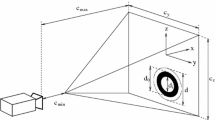Abstract
To meet the requirements for motion estimation of a swarm of micro-aerial vehicles in a GPS-restricted environment, a distributed motion estimation algorithm is proposed that combines an inertial measurement unit, magnetometer, wireless ranging network and altimeter data. Based on the information sharing and mutual positioning ability of the wireless sensor network, the long-term stability of motion estimation in a GPS-restricted environment is improved on the basis of information from neighboring vehicles. A centralized information filter for large-scale swarm micro-aerial vehicles is proposed that uses the information distribution principle. To address the difficulty of high-dimensional state inversion in centralized information filtering, the theory of distributed information filters for large-scale systems is adopted to decompose the high-dimensional optimal centralized information filter into distributed sub-filters. Based on the logged data, the simulation results show that the accuracy of motion estimation using the distributed filtering method is not significantly lower than with centralized filtering, and is more suitable for distributed deployment on micro-aerial vehicles, enabling stable motion estimation to be maintained in a GPS-restricted environment.












Similar content being viewed by others
References
Zhou Y, Rao B, Wang W (2020) UAV swarm intelligence: recent advances and future trends. IEEE Access 8:183856–183878. https://doi.org/10.1109/ACCESS.2020.3028865
Fan JR, Li DG (2020) Analysis on MAV/UAV cooperative combat based on complex network. Defence Technol 16(01):154–161. https://doi.org/10.1016/j.dt.2019.09.002
Ye F, Chen J, Sun Q, Tian Y, Jiang T (2021) Decentralized task allocation for heterogeneous multi-UAV system with task coupling constraints. J Supercomput 77(1):111–132. https://doi.org/10.1007/s11227-020-03264-4
Bürkle A, Segor F, Kollmann M (2011) Towards autonomous micro UAV swarms. J Intell Rob Syst 61(1–4):339–353. https://doi.org/10.1007/s10846-010-9492-x
Coppola M, McGuire KN, De Wagter C (2020) A survey on swarming with micro air vehicles: Fundamental challenges and constraints. Front Robot AI 7:18. https://doi.org/10.3389/frobt.2020.00018
Bijjahalli S, Sabatini R, Gardi A (2020) Advances in intelligent and autonomous navigation systems for small UAS. Prog Aerosp Sci. https://doi.org/10.1016/j.paerosci.2020.100617
Hong E, Lim J (2017) Visual inertial odometry using coupled nonlinear optimization. 2017 IEEE/RSJ International Conference on Intelligent Robots and Systems (IROS). IEEE pp 6879–6885. https://doi.org/10.1109/IROS.2017.8206610
Tomic T, Schmid K, Lutz P (2012) Toward a fully autonomous UAV: Research platform for indoor and outdoor Urban search and rescue. Robot Autom Mag IEEE 19(3):46–56. https://doi.org/10.1109/MRA.2012.2206473
Wang R, Di K, Wan W (2018) Improved point-line feature based visual SLAM method for indoor scenes. Sensors. https://doi.org/10.3390/s18103559
Dissanayake M, Newman P, Clark S (2013) A solution to the simultaneous localization and map building (SLAM) problem. IEEE Trans Ra 17(3):229–241. https://doi.org/10.1109/70.938381
Cadena C, Carlone L, Carrillo H (2016) Past, present, and future of simultaneous localization and mapping: toward the robust-perception age. IEEE Trans Rob 32(6):1309–1332. https://doi.org/10.1109/TRO.2016.2624754
Yu S, Nuske S, Scherer S (2017) A multi-sensor fusion MAV state estimation from long-range stereo, IMU GPS and barometric sensors. Sensors 17(12):11. https://doi.org/10.3390/s17010011
Kumari J, Kumar P, Singh SK (2019) Localization in three-dimensional wireless sensor networks: a survey. J Supercomput 75(8):5040–5083. https://doi.org/10.1007/s11227-019-02781-1
Barczyk M, Lynch AF (2012) Integration of a triaxial magnetometer into a helicopter UAV GPS-aided INS. IEEE Trans Aerosp Electron Syst 48(4):2947–2960. https://doi.org/10.1109/TAES.2012.6324671
Li Y, Zahran S, Zhuang Y (2019) IMU/magnetometer/barometer/mass-flow sensor integrated indoor quadrotor UAV localization with robust velocity updates. Remote Sens 11(7):838. https://doi.org/10.3390/rs11070838
Li J, Bi Y, Li K (2018) Accurate 3D localization for MAV swarms by UWB and IMU fusion. 2018 IEEE 14th International Conference on Control and Automation (ICCA). IEEE pp 100–105. https://doi.org/10.1109/ICCA.2018.8444329
Queralta J P, Almansa C M, Schiano F(2020) UWB-based system for UAV Localization in GNSS-Denied Environments: Characterization and Dataset. arXiv preprint. arXiv:2003.04380arXiv:2003.04380https://doi.org/10.1109/IROS45743.2020.9341042
Xu H, Wang L, Zhang Y (2020) Decentralized visual-inertial-UWB fusion for relative state estimation of aerial swarm. 2020 IEEE International Conference on Robotics and Automation (ICRA). IEEE, pp 8776–8782. https://doi.org/10.1109/ICRA40945.2020.9196944
Yang C, Strader J, Gu Y (2020) Cooperative navigation using pairwise communication with ranging and magnetic anomaly measurements. J Aerosp Inf Syst 17(11):624–633. https://doi.org/10.2514/1.I010785
Goel S (2017) A distributed cooperative uav swarm localization system: Development and analysis. Proceedings of the 30th International Technical Meeting of The Satellite Division of the Institute of Navigation (ION GNSS+ 2017) pp 2501–2518. https://doi.org/10.33012/2017.15217
Welch G (2001) Kalman filter. Siggraph Tutorial 8(27599–23175):41
Assimakis N, Adam M, Douladiris A (2012) Information filter and kalman filter comparison: selection of the faster filter. Inf Eng 2(1):1–5
Ryu K, Back J (2019) Distributed Kalman-filtering: Distributed optimization viewpoint. 2019 IEEE 58th Conference on Decision and Control (CDC). IEEE pp 2640–2645. https://doi.org/10.1109/CDC40024.2019.9029645
Bai H, Freeman RA, Lynch KM (2011) Distributed Kalman filtering using the internal model average consensus estimator. Proceedings of the 2011 American Control Conference. IEEE pp 1500–1505. https://doi.org/10.1109/ACC.2011.5991484
Kim J, Shim H, Wu J (2016) On distributed optimal Kalman-Bucy filtering by averaging dynamics of heterogeneous agents. 2016 IEEE 55th Conference on Decision and Control (CDC). IEEE pp 6309–6314. https://doi.org/10.1109/CDC.2016.7799240
Battistelli G, Chisci L, Mugnai G (2014) Consensus-based linear and nonlinear filtering. IEEE Trans Autom Control 60(5):1410–1415. https://doi.org/10.1109/TAC.2014.2357135
Battistelli G, Chisci L (2016) Stability of consensus extended Kalman filter for distributed state estimation. Automatica 68:169–178. https://doi.org/10.1016/j.automatica.2016.01.071
Khan UA, Moura JMF (2008) Distributing the Kalman filter for large-scale systems. IEEE Trans Signal Process 56(10):4919–4935. https://doi.org/10.1109/TSP.2008.927480
Talebi SP, Werner S (2019) Distributed Kalman filtering and control through embedded average consensus information fusion. IEEE Trans Autom Control 64(10):4396–4403. https://doi.org/10.1109/TAC.2019.2897887
Ming Y (2010) High dimensional inverse covariance matrix estimation via linear programming. J Mach Learn Res 11(8):2261–2286
https: //dev.px4.io/zh/tutorials/tuning_the_ecl_ekf.html.
https://docs.px4.io/master/en/flight_controller/pixhawk4.html
Sidorenko J, Schatz V, Scherer-Negenborn N (2020) Error corrections for ultra-wideband ranging. IEEE Trans Instrum Measure 69(11):9037–9047. https://doi.org/10.1109/TIM.2020.2996706
Funding
This research was funded by national key laboratory fund, Grant Number 94767699.
Author information
Authors and Affiliations
Corresponding author
Ethics declarations
Conflict of interest
We declare that we do not have any commercial or associative interest that represents a conflict of interest in connection with the work submitted.
Additional information
Publisher's Note
Springer Nature remains neutral with regard to jurisdictional claims in published maps and institutional affiliations.
Rights and permissions
About this article
Cite this article
Lou, W., Wang, J., Su, Z. et al. Application of distributed motion estimation for swarm MAVs in a GPS-restricted environment based on a wireless sensor network. J Supercomput 78, 9840–9861 (2022). https://doi.org/10.1007/s11227-021-04219-z
Accepted:
Published:
Issue Date:
DOI: https://doi.org/10.1007/s11227-021-04219-z




